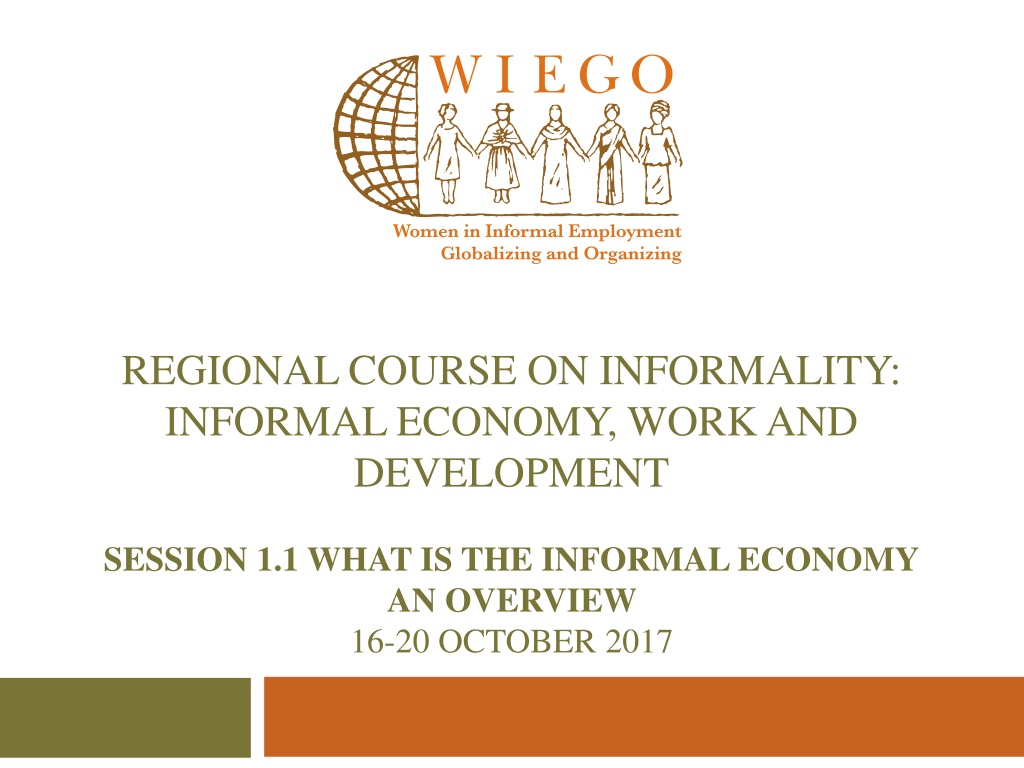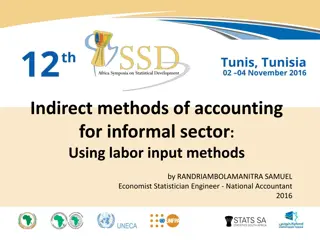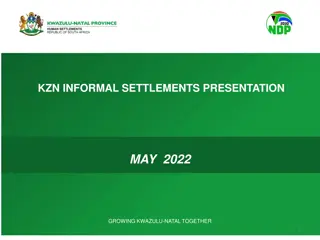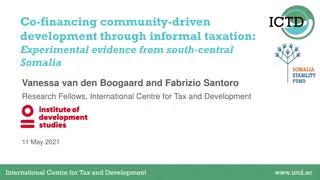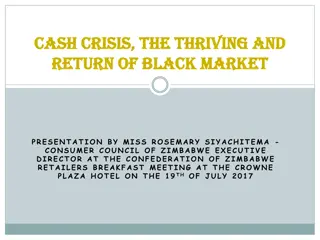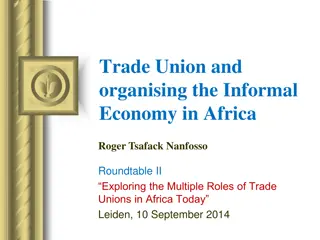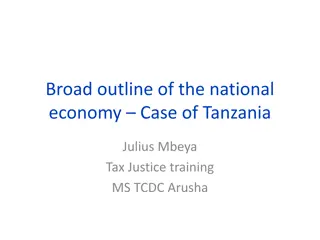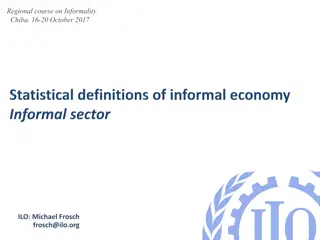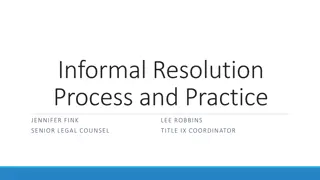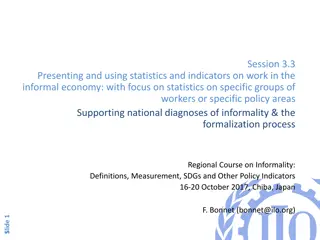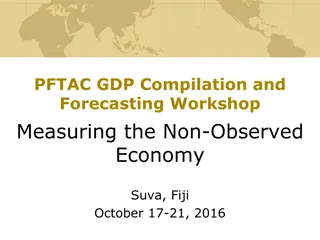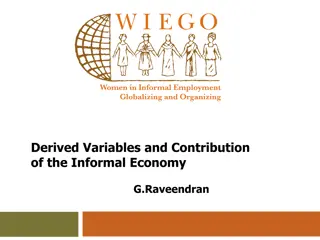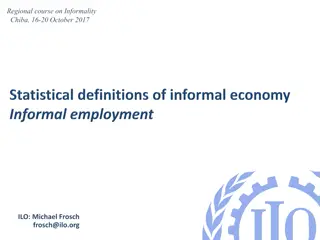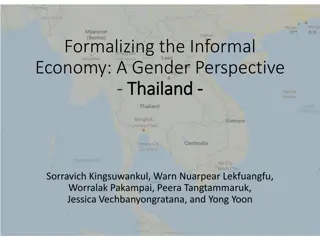Understanding the Informal Economy: An Overview
Delve into the intricate world of the informal economy, exploring its significance, measurement objectives, and the various schools of thought that make it a controversial topic. Gain insights into the definitions of the informal sector, employment, and economy, and understand the framework and categories of informal employment. Uncover the complexities of informal economic activities, enterprises, and workers that operate outside formal regulations and state protection.
Download Presentation

Please find below an Image/Link to download the presentation.
The content on the website is provided AS IS for your information and personal use only. It may not be sold, licensed, or shared on other websites without obtaining consent from the author. Download presentation by click this link. If you encounter any issues during the download, it is possible that the publisher has removed the file from their server.
E N D
Presentation Transcript
REGIONAL COURSE ON INFORMALITY: INFORMAL ECONOMY, WORK AND DEVELOPMENT SESSION 1.1 WHAT IS THE INFORMAL ECONOMY AN OVERVIEW 16-20 OCTOBER 2017
Outline of Presentation What is the informal economy Significance of the informal economy Progress in development of statistics on the informal economy Measurement objectives/uses of data
The Informal Economy What is it? Why is it controversial? Different Schools of Thought make Informal Economy controversial: entrepreneurial activities/enterprises: capable of independent dynamic growth survivalist activities/enterprises: not capable of dynamic growth without support subordinated activities/enterprises/workers: dependent on or exploited by large formal sector firms e.g. value chains of production criminal-underground activities/units: dealing with illegal goods or services or legal activities which are not declared to avoid paying taxes,etc. ICLS and Approach of this course: informal economy includes all of the above + informal wage workers employed by informal enterprises, formal enterprises, households, and no fixed employer most informal workers are engaged in survivalist self-employment or informal wage employment; many are sub-contracted by large formal sector firms
Concepts There are three related official statistical terms and definitions which are often used imprecisely and interchangeably by analysts and observers: informal sector refers to the production and employment that takes place in unincorporated small or unregistered enterprises (1993 ICLS) informal employment refers to employment without social protection (i.e. without employer contributions) both inside and outside the informal sector (2003 ICLS) informal economy refers to all units, activities, and workers so defined and the output (contribution to GDP) from them In sum, the informal economy is the diversified set of economic activities, enterprises and workers that are not regulated or protected by the state; and the output from them.
Concepts-continued Does the informal sector capture all employment that is not formal?
Informal Employment Framework and Status in Employment Categories Persons employed in the informal sector own account operators in their own informal enterprises employers in informal enterprises employees of informal enterprises contributing family workers in informal enterprises members of informal producer cooperatives Persons in informal employment outside the informal sector: employees of formal firms not covered by social protection, national labour legislation, or entitlement to certain employment benefits such as paid annual or sick leave domestic workers hired by individuals/households not covered by social protection, national labour legislation or entitlement to employment benefits Contributing family workers in formal enterprises
Significance The informal economy is large by whatever measure is used: share of : around 70 % of employment in developing regions (ILO estimates,2017) - 88 % is Southern Asia highest of Asian sub-regions (based on data from Bangladesh, India, Nepal Pakistan, Sri Lanka) share of enterprises: own account enterprises alone (i.e., those without hired workers) account for 85% of total enterprises in India (National Sample Survey Organisation 2012) share of GDP: informal enterprises (i.e., the informal sector) contribute 25-50% per cent of non-agricultural Gross Value Added in developing countries (ILO-WIEGO 2013) - 46.8 % contribution of informal (unorganized) sector India 2008
Highlights of Progress in Development of Statistics on the Informal Economy 1993 - ICLS Recommendation on employment in the informal sector 2003 - ICLS Guidelines concerning a statistical definition of informal employment 1993 and 2008 Recognition of informal sector by national accountants, first in 1993 Guidelines and then in more detail in 2008 System of National Accounts 2013 Mexico s use of informal employment and employment in the informal sect as key economic indicators 2013 2018 Revision of the International Classification of Status in Employment largely to better identify informal workers 2015 Informal employment and employment in informal sector included in ILOSTAT the main statistical database 2015- SDG Indicator 8.3.1 Share of informal employment in non-agricultural employment by sex for Goal 6. Promote sustained, inclusive and sustainable economic growth, full and productive employment and decent work for all
INFORMAL ECONOMY-- KEY MACRO- ECONOMIC INDICATORS IN MEXICO Informal Economy as a Share of GDP, by Component. Series 2003-2015 Other Forms of Informality Informal Economy Informal Sector Year 27.2 26.5 26.3 25.6 25.5 25.3 26.8 26.2 25.7 25.4 24.9 23.9 23.6 11.8 11.3 11.3 10.7 10.4 9.5 12.3 11.7 11.7 11.2 11.3 11.2 11.3 15.4 15.2 15.0 14.9 15.1 15.8 14.5 14.6 14.0 14.2 13.6 12.8 12.3 2003 2004 2005 2006 2007 2008 2009 2010 2011 2012 2013 2014R 2015P RRevised figures as from date indicated. PPreliminary figures as from date indicated. Source: INEGI. SNA, Measuring the Informal Economy; October 11, 2017, from http://www.inegi.org.mx/est/contenidos/proyectos/cn/informal/default.aspx
Highlights continued Application of the concept of informal employment to developed countries Why is this important? Production and employment are being organized into more decentralized, flexible and specialized units; such arrangements would be labeled informal employment in developing countries Raises the importance of the concept to have it apply world-wide What has been done? WIEGO and ILO launched efforts with an expert group in 2008 An experimental indicator in Measurement of Quality of Employment an expert group comprised of developed countries, ECE, ILO and EUROSTAT. New ILO estimates: informal employment=17 % of employment in developed countries and a global estimate of 61%
Highlights of Progress in the Availability of Statistics on the Informal Economy 2002 and 2013 - first and second issues of ILO/WIEGO Women and Men in the Informal Economy compilations of the available data from countries --number of countries with data on informal employment increased to 44 countries in the 2ndedition 2002 and 2014 -2 sets of regional estimates of informal employment in developing countries, the most recent in Statistics on the Informal Economy: Definitions, Regional Estimates and Challenges WIEGO Working Paper No. 2 New ILO estimates of informal employment and employment in the informal sector based on 118 countries using micro-data files of countries] Question: in preparing statistics do you use nationally supplied or estimates or produce estimates using the available microdata files
ADDITIONAL MEASUREMENT OBJECTIVES/USES OF DATA Labour regulations New employment arrangements-casual and contract labour call for statistics on informal employment to: advocate for and to develop labour standards understand the special situation of socio-demographic categories of workers e.g. women, racial and ethnic groups in order to design interventions shed light on the debate on labor market reform now occurring in many of the region s countries which aims at increasing labour market flexibility
MEASURMENT OBJECTIVES/USES OF DATA- continued Small enterprise development- Starting point: data show that in most of the region s countries the great majority of enterprises are small and therefore should be the target for programmes aimed at job creation and income generation data are needed for designing and implementing programmes to increase this potential what is needed by home-based workers, by street and market vendors Statistics also identify special problems faced by women entrepreneurs
MEASUREMENT OBJECTIVES/USES OF DATA - continued Poverty reduction Links between poverty and informal employment - many of the working poor are in informal employment - informal employment can be the most effective means for persons to rise out of poverty e.g. Study in India: poor households income below the poverty line and very poor households - income less than 75 % of poverty line Findings: Households depending on informal, regular wage employment have lower poverty rates; highest poverty rates are among households that sustain on casual wage employment Thus programmes to improve the economic well being of the poor need to be backed up by statistics on informal employment.
Segmentation of Informal Employment by Poverty Risk, Earnings and Sex
MEASURMENT OBJECTIVES Continued Monitoring the transition from the informal to the formal economy (ILC) Section VIII Data Collection and Monitoring Members should, in consultation with employers and workers organizations, on a regular basis: 36. where possible and as appropriate, collect, analyse and disseminate statistics disaggregated by sex, age, workplace, and other specific socio-economic characteristics on the size and composition of the informal economy, including the number of informal economic units, the number of workers employed and their sectors Monitor and evaluate the progress toward formalization
DEVELOPMENT OF STATISTICS ON INFORMAL ECONOMY AS A DEMAND DRIVEN PROCESS Advocates need statistics to establish the importance/ legitimacy of requests for change in policies and programmes India: SEWA and insurance for bidi workers; Thailand: HomeNet ILO Convention on homeworkers (1996) Importance of a dialogue between producers (statisticians) and users of statistics (labour ministry officials, activists, advocates, researchers NSSO and CSO India/SEWA; Thailand National Statistical Office and HomeNet Thailand and WIEGO ILO Statistics - WIEGO
